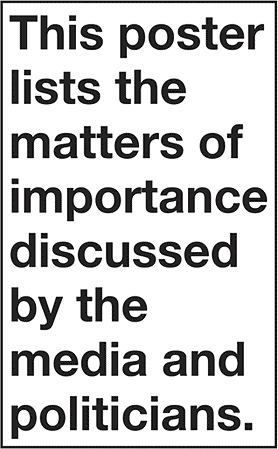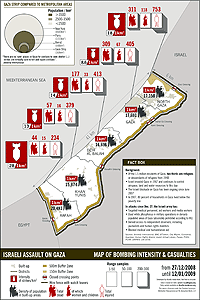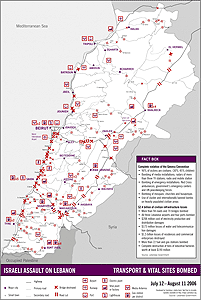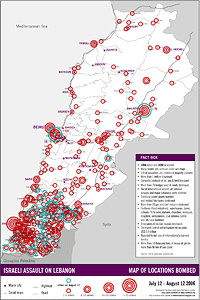January 2009
 “Little gifts - and lots of them - are the holy grail.” Some interesting links and case studies for non-profit organizations.
“Little gifts - and lots of them - are the holy grail.” Some interesting links and case studies for non-profit organizations.When Design Stopped the War
“But does it work?”
It’s one of those frequently asked questions one often hears at discussions of design and activism. That and the whole preaching to the converted thing. It refers to design specifically, but also protest generally.
It sometimes takes a long time to stop a war, but now and then the impact is immediate. Like the time in February 1998 when protestors disrupted an internationally broadcast “Town Meeting” on Iraq at Ohio State University. Students dropped a NO WAR banner in front of an CNN’s rolling cameras and made such a ruckus that the moderator had to allow them a turn at the mic. Their pointed questions about the war embarrassed the Clinton Administration, tipped public and international support, and prevented an invasion of Iraq. “Not even Ohio supports the bombing, Egyptian President Hosni Mubarak said a few days later. Why should Egypt?”
Of course, it wasn’t this one protest alone, nor solely the banner smuggled into the event. But the action, broadcast around the world via cable news, sealed the deal. Katha Pollit’s March 1998 article tells the story.
Update 3/16/2010: Here’s a transcript of the town hall meeting.
Discourse on Method
Made me laugh. Designed by Jorge Arrieta.
Crosswalk Memorial
This YouTube video documents pedestrian advocates in Lisbon, Portugal replacing the white “zebra” stripes in a crosswalk with the stenciled names of 137 pedestrians killed by cars. On the curb, the tagline reads: “1/4 das vítimas de acidentes de automóvel são peões.” 1/4 of the victims of automoboile accidents are pedestrians.
The typographic crosswalks were installed in May 2007 at four locations by the ad agency DraftFCB Lisbon for the advocacy group Associação de Cidadãos Auto-Mobilizados with support from Liberty Insurance and JC Decaux. The action generated a bit of media attention to the issue during “Safe Street Week.” (via)
Solidarity Maps
The maps below visualize some of the impact of Israeli attacks on civilians and civilian infrastructure in Lebanon and the Gaza Strip. About the designers:
“We are a group of Lebanese a group of Lebanese, Palestinian, and other activists who have worked together previously, mainly doing media and mapping work during the summer 2006 Israeli attack on Lebanon, and some of us later on advocacy and design for the reconstruction of Nahr el-Bared refugee camp. We have among us designers, architects, researchers, media people, and many other random activists. Although we are not an organised body or politically affiliated with a specific group, we are all pro-Palestinian.”
Gaza - Map of Bombing Intensity & Casualties, December 27, 2008—January 12, 2009
Lebanon - transport & vital sites bombed, July 12—August 12, 2006
Israeli Assault on Lebanon, July 12—August 12, 2006
 A brief look at non-profit ads and political graffiti depicting President Bush over the last 8 years. See also Bush Billboards and GWB in international advertisements. I hope the next time we see this guy’s mug it’ll be on the witness stand.
A brief look at non-profit ads and political graffiti depicting President Bush over the last 8 years. See also Bush Billboards and GWB in international advertisements. I hope the next time we see this guy’s mug it’ll be on the witness stand.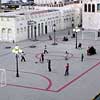 Curated by the Canadian Centre for Architecture, a list of 99 creative, public interventions for civic improvement. See, for instance, Illicit Stencil Saves Cyclists and Reclaim Vacant Lot with What City’s Got. ( via ag, gi)
Curated by the Canadian Centre for Architecture, a list of 99 creative, public interventions for civic improvement. See, for instance, Illicit Stencil Saves Cyclists and Reclaim Vacant Lot with What City’s Got. ( via ag, gi)
 “Protests were held in Britain, France, Germany, Greece, Ireland, Italy, the Netherlands, Spain and Turkey as the Israeli offensive entered its second week...In many cities people waved shoes — recalling the action of an Iraqi journalist who hurled footwear at U.S. President George W. Bush in Baghdad last month in a symbolic insult. British demonstrators threw dozens of shoes into the street as they passed the gated entrance to Downing Street, where Prime Minister Gordon Brown lives, and shouted angrily at a line of 40 police officers on guard there. ‘Come to get your shoes Gordon,’ one woman shouted as other marchers directed chants of ‘Shame on you’ at Brown.”
“Protests were held in Britain, France, Germany, Greece, Ireland, Italy, the Netherlands, Spain and Turkey as the Israeli offensive entered its second week...In many cities people waved shoes — recalling the action of an Iraqi journalist who hurled footwear at U.S. President George W. Bush in Baghdad last month in a symbolic insult. British demonstrators threw dozens of shoes into the street as they passed the gated entrance to Downing Street, where Prime Minister Gordon Brown lives, and shouted angrily at a line of 40 police officers on guard there. ‘Come to get your shoes Gordon,’ one woman shouted as other marchers directed chants of ‘Shame on you’ at Brown.”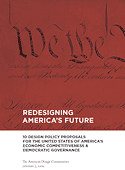
The results of a meeting held in Washington DC on November 30, 2008, this concise policy brief proposes a consolidated design policy that fosters “economic competitiveness & democratic governance.” The proposals are:
- Formalize an American Design Council to partner with the U.S. Government.
- Set guidelines for legibility, literacy, and accessibility for all government communications.
- Target 2030 for carbon neutral buildings.
- Create an Assistant Secretary for Design and Innovation position within the Department of Commerce to promote design.
- Expand national grants to support interdisciplinary community design assistance programs based on human-centered design principles.
- Commission a report to measure and document design’s contribution to the U.S. economy.
- Revive the Presidential Design Awards to be held every year and use triple bottom-line criteria (economic, social, and environmental benefit) for evaluation.
- Establish national grants for basic design research.
- Modify the patent process to reflect the types of intellectual property created by designers.
- Encourage direct government investment in design innovation.
The site is currently accepting comments on the proposals.


